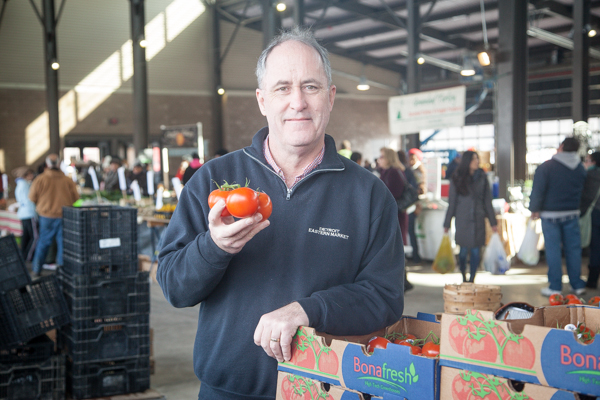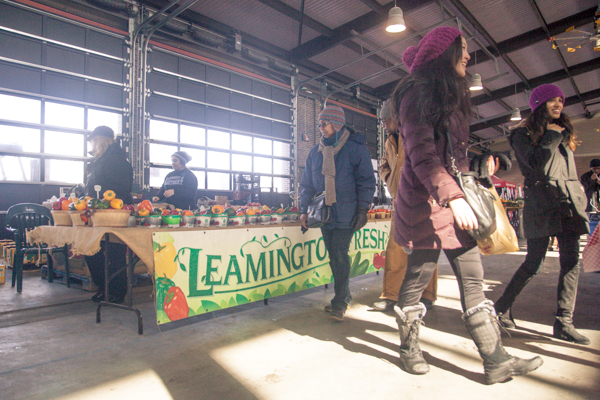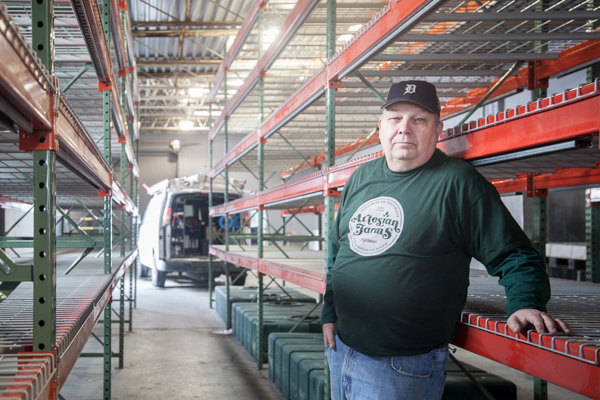Frigid temperatures and snow don't mean you have to rule out eating fresh, regionally-sourced vegetables. Winter food production is alive and thriving in and around Michigan thanks to greenhouse growing and other season-extending technologies.
This can be seen on display any snowy Saturday at Detroit's
Eastern Market, where you can stroll through the sheds and scoop up handfuls of fresh Detroit-grown sunflower shoots or Canadian-cultivated peppers from across the river in Leamington, Ontario.
While local produce is not as plentiful as the warmer months, Eastern Market's president Dan Carmody says the public market still has ample offerings for locovores.
"There are root crops that are harvested in the fall -- potatoes, onions, beets -- that are stored and sold until supplies run out," he says. "There are area greenhouses, principally from Leamington, Ontario and some Michigan locations [that sell] peppers, tomatoes, cucumbers, some lettuces and spinach."
Carmody adds that some growers are also taking advantage of season-extension innovations like hoophouses to grow microgreens, lettuce, and herbs.
 Dan Carmody, president of Eastern Market Corp.
Dan Carmody, president of Eastern Market Corp.
Eastern Market isn't alone in local winter offerings. Year-round farmers markets are increasing in popularity around the state in places as far apart as Royal Oak, Lansing, and Frankfort.
Retailers like Meijer and Whole Foods also offer regionally-sourced foods, as do restaurants like Ann Arbor's Grange Kitchen, Royal Oak's Inn Season Cafe, and Detroit's Brooklyn Street Local. It may take a little investigating, but winter options are definitely on the menu for Michiganders with a taste for homegrown foods.
So how are farmers growing these crops despite the cold and snow of a Michigan winter? Greenhouse growing is definitely a time-honored solution to this problem. This style of growing relies on structures with glass or plastic tops that allow sunlight to enter, nourishing plants while trapping warm air inside their walls.
Michigan greenhouses come in all shapes and sizes, from family operations like Detroit's
Rising Pheasant Farms, which grows sprouted greens, shoots, and transplants in a tiny side lot structure, to the Canadian company Mastronardi's 70,000 square-foot commercial
tomato-growing facility in Coldwater near the Indiana border.
The regional heart of the industry, though, can be found across the Detroit River in the Canadian city of Leamington.
"Leamington is an important part of Detroit's food ecosystem," Carmody says. "It's probably the largest concentration of greenhouses in North America. They grow enormous quantities of tomatoes, peppers, zucchini, and cucumbers and a few other crops."
 Leamington Farms stand in Shed 5 at Eastern Market
Leamington Farms stand in Shed 5 at Eastern Market
Leamington's
Nature Fresh Farms bills itself as "the largest independent greenhouse produce grower in Canada." Its facilities span 130 acres, most dedicated to peppers and tomatoes. Nature Fresh is a high end operation that makes use of hydroponic growing and climate control technologies as well as an automatic packing line.
High-tech growing techniques aren't limited to greenhouses, though. Michigan is also fertile ground for cutting-edge technologies like hydroponics, which cultivates plants in a soil-free solution of water and mineral nutrients, and aquaponics, a similar technique that also integrates living aquatic organisms.
Artesian Farms Detroit is a brand-new hydroponic facility located in a 7,200 square foot building in Detroit's Brightmoor neighborhood that's will begin operations in March. Last week, workers set up eleven vertical growing towers, each of which can produce about 75 to 100 pounds of food. Harvesting takes roughly 22 days.
Jeff Adams, Artesian's owner, says the facility will start off growing leafy greens like lettuce and chard, but the year-round growing season offers a lot of flexibility.
"Because our window for growing is so short, we can alter products," Adams says. "We might grow tomatoes or cucumbers in the winter when you can't get it locally grown, then we change in the summer, so we're not competing against local farmers."
 Jeff Adams stands between the growing racks at Artesian Farms
Jeff Adams stands between the growing racks at Artesian Farms
The guiding purpose behind the business, a social enterprise, is to create living wage jobs for local residents and to provide them with a skillset that will allow them to set up their own hydroponic operations.
"I think there's tons of opportunity to this," says Adams. "Detroit will be the first to do this. There's probably hundreds of buildings like this that would be possible to convert to hydroponic vertical growing."
Michigan farmers are also increasingly relying on a season extending technology known as hoophouses, or high tunnels, for winter production. Named for their hoop-shaped frames, these structures are essentially greenhouses without supplemental heat or lighting.
Adam Montri is a hoop house outreach specialist with Michigan State University's Department of Horticulture. He says that hoophouse farmers usually plant between late August and mid-October, depending on the structures used to keep plants dormant but alive during the early winter.
"Basically it's acting like a big refrigerator," he says. "We're getting a little bit of growth up until
December-January, then right about now were starting to get enough lights for plants to start to grow again."
Spinach, salad mix, carrots, chard, scallions, and beets are a few of the crops that are well suited for this type of growing.
According to Montri, Michigan is a national leader in the adoption of hoophouses. By his count, over a thousand are in use throughout in the Great Lakes State. He credits the popularity of hoophouses in Michigan to the pioneering work of horticulture professor John Biernbaum and MSU's student organic farm.
Hoophouses also are gaining ground nationally, he adds, thanks to a U.S. Department of Agriculture's incentive program and the fact that they're so much cheaper than greenhouses due to the absence of overhead expenses.
Changing demographics among farmers are also playing a role in the adoption of this technology. Montri says he's starting to see an influx of young farmers who don't come from an agricultural background, a trend that could bode well for other types of winter growing operations too.
"They're not used to having this kind of boom and bust [cycle] of make a lot of money in the summer and use that money to live through the winter," he says. "They have taken hoop houses as part of their business plan from the get-go to be able to have that year-round income."
Support for this series on food and agriculture in Southeast Michigan is provided in part by the Detroit Food and Agriculture Network. See other stories in this series here.
---
David Sands is a Detroit-based freelance writer. Follow him on Twitter @dsandsdetroit.
All photos by Marvin Shaouni.